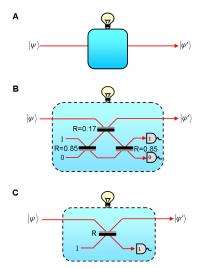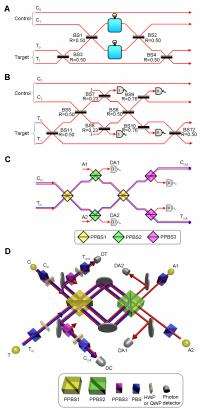June 24, 2011 feature
All-optical quantum computation, step 1: A controlled-NOT photonic gate

(PhysOrg.com) -- The often counterintuitive quantum world of superposition, entanglement, and tunneling can greatly enhance applications as diverse as communication, information processing, and precision measurement. At the same time, photons have the equally attractive properties of low noise, light speed transmission, and ease of manipulation using conventional optics. However, due to the probabilistic nature of single photons, the two have never been integrated into a single system – until now. Researchers have developed a stable architecture that, by instantiating a fundamental feature of the proposed KLM controlled-NOT (CNOT) gate, proposed a decade ago, as an element in a photonic quantum circuit, is expected to allow on-demand entanglement generation and purification through scalable quantum computation.
Originally described by E. Knill, R. Laflamme and GJ Milburn (KLM) in 2001, a controlled-NOT (CNOT) gate flips the polarization state of the target photon conditional on the control photon being horizontally polarized (the logical 1 state). The gate is capable of generating maximally entangled two-qubit states, which together with one-qubit rotations provide a universal set of logic gates for quantum computation. This remained a theoretical design until Prof. Shigeki Takeuchi and lead researcher Asst. Prof. Ryo Okamoto at Hokkaido University’s Research Institute for Electronic Science and Osaka University’s Institute of Scientific and Industrial Research, with Prof. Jeremy O’Brien at University of Bristol’s Center for Quantum Photonics, and Assoc. Prof. Holger Hofmann at Hiroshima University’s Graduate School of Advanced Sciences of Matter developed and demonstrated their CNOT gate.
It was a daunting task: The KLM-CNOT optical quantum circuit has faced a number of obstacles since being proposed in 2001, the two most challenging being the lack of heralding (indistinguishable) single photon sources and the difficulty of stabilizing nested multiple optical path interferometers. Moreover, heralding is critical: Even though photonic quantum controlled-NOT gates have been demonstrated, most of them are not heralded. This requires that gate output must be measured to know if the operation was successful or not, and is therefore not suited for use in quantum circuits – and only heralded gates can be used to achieve scalable optical quantum computation that employs linear optical components.
Another difference is that the new quantum circuit combines effective nonlinearities induced via quantum interference of photons at a beam splitter, as first suggested by KLM. Other heralded gates demonstrated use different entanglement resources, such as entangled photon pairs or quantum teleportation.
“The effective optical nonlinearities embedded in the KLM-CNOT circuit rely on the quantum interference between indistinguishable single photons at a beam splitter using parametric down conversion (SPDC) sources,” Takeuchi explains to PhysOrg.com. “If these photons are distinguishable, photons behave like classical particles – and the genuine quantum feature of the circuit disappears. For the KLM-CNOT circuit, single photon sources with very high indistinguishability are required. Moreover, we have to stabilize at least four nested optical path interferometers and maintain their optical paths for several days.” The team overcame this problem by using a very compact 10cm2 displaced-Sagnac interferometer and several partially polarizing beam splitters – and to improve the design further, adds Takeuchi, the team may implement the optical quantum circuit with optical wave guides. This would reduce circuit size by more than an order of magnitude to less than 1cm2.

However, there remains a critical problem with SPDC sources: the ever-present possibility that the source will emit more than one photon. Excess photons lead to significant errors, especially as the number of photons in a quantum circuit increases. For post-SPDC sources, single-photon sources using atoms embedded in a micro-optical cavity are the most advanced – but they typically require an ultra-high vacuum environment and may be difficult to operate continuously, making system integration difficult.
To address these issues, Takeuchi says that solid state single-photon sources using nanoscale light emitters, like single quantum dots or nitrogen vacancy (NV) centers in diamonds, are promising candidates. In fact, the team is now studying devices using NVs coupled with microsphere resonators and tapered optical fibers. “When such single photon sources are developed, we can implement single photon sources and optical quantum circuits in a tiny photonic chip, which could be used not only for quantum communication but also quantum metrology, which allows us to realize sensitivity beyond the standard quantum limit.”
Further down the road, Takeuchi’s team will focus on developing a photonic quantum chip in which single photon sources, photon detectors, and nonlinear sign shift gates (photonic switches) are all embedded in a chip to form a functional quantum circuit. “Such a quantum circuit will be a building block of quantum information systems,” he notes, “and will be useful in quantum metrology.”
In terms of applications, says Takeuchi, “the primary near-term use will be in quantum measurement,” says Takeuchi. After that, he sees enhanced sensitivity using non-classical photonic states being useful in broad areas of science, from gravitational wave detection to cell biology. “I believe such an optical quantum circuit will be useful for nanochemistry, where the number of probe photons has to be very small.”
In the future, he concludes, controlled generation of entangled photon states is a significant step towards entanglement swapping, quantum teleportation, quantum cryptography and scalable approaches towards photonics-based quantum computing. “Optical quantum circuits will of course be useful for long-distance quantum key distribution in quantum communication, simulation and computation.”
More information: Realization of a Knill-Laflamme-Milburn controlled-NOT photonic quantum circuit combining effective optical nonlinearities, PNAS, Published online before print June 6, 2011, doi: 10.1073/pnas.1018839108
Copyright 2011 PhysOrg.com.
All rights reserved. This material may not be published, broadcast, rewritten or redistributed in whole or part without the express written permission of PhysOrg.com.


















